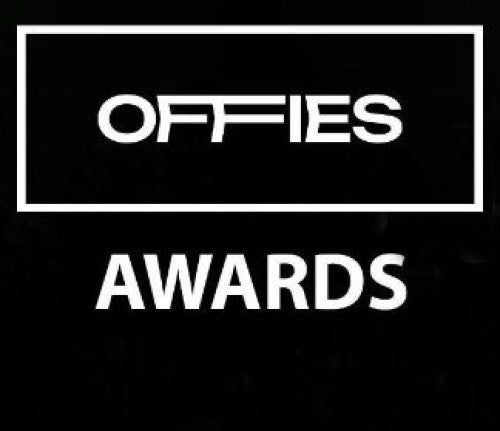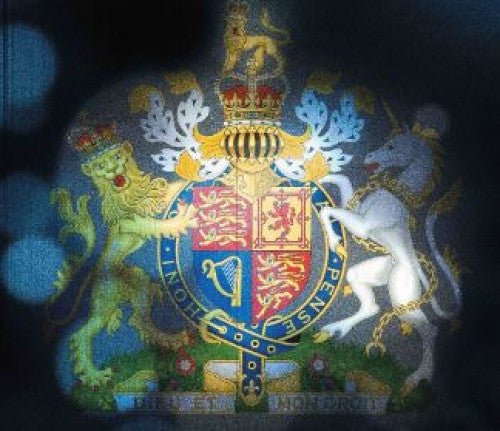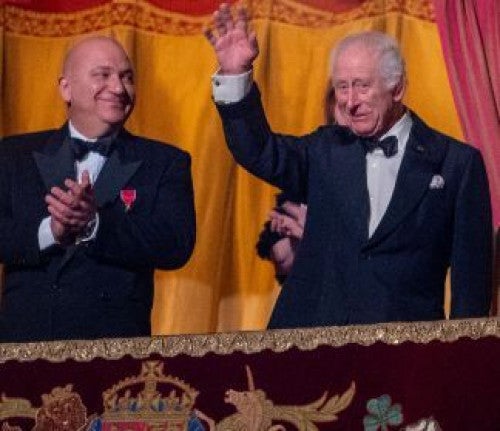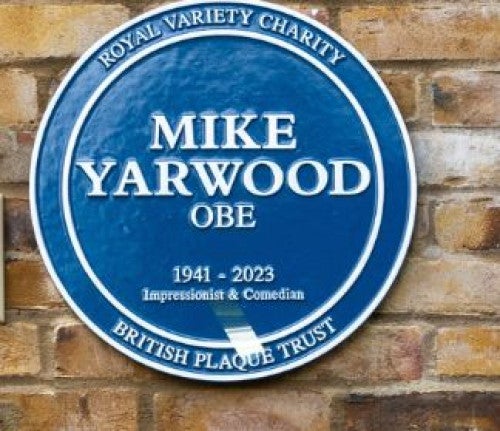History of the Royal Variety Performance
Please visit our huge Archive section to see year by year, the enormous amount of acts from around the globe, who have performed at the Royal Variety Performance and view the original show programmes.
-
1912 - Royal Command Performance
-
The origins of the Royal Variety Performance date back to 1912, when His Majesty King George V and Her Majesty Queen Mary agreed to attend a 'Royal Command Performance' at the Palace Theatre in London's Cambridge Circus in aid of the VABF - Variety Artistes' Benevolent Fund (the previous name of the Royal Variety Charity) and its proposed plans to build an extension to its Care Home for elderly entertainers, Brinsworth House. This first staging was a lavish occasion with over 3 million roses draped around the auditorium.
On conception the show was dubbed with the working-title 'the Music Hall Command Performance' but was soon altered before the day of the show to become the very first Royal Command Performance and must still rank as one of the most successful.
All the great names of British variety and music hall gathered at the Palace Theatre before King George V, Queen Mary and the Prince of Wales. All that is, apart from Marie Lloyd, perhaps the biggest name in popular music hall at the time. Her ommission - apparently on the grounds that she was too risque for such a Royal performance at a time when music hall was just becoming 'respectable' - is one of the most controversial in the history of the Royal Variety Performance.
Her absence, however, failed to dampen excitement of a memorable night of British entertainment, with stars such as comic Harry Lauder, Harry Tate, the 'Prime Minister of Mirth' George Robey, dancer Anna Pavolva and the 'White-Eyed Kaffir' G.H.Chirgwin, ensuring triumph.
There was one moment of unease, when Vesta Tilley, the talented male impersonator, began her act. Queen Mary, seemingly unhappy with the idea of a woman wearing trousers and dressing like a man, covered her face with her programme, which encouraged the audience to be less enthusiastic in their reception to Miss Tilley. Fortunately, following her act was the great comic, Harry Tate, and his ability to get George V laughing soon restored the lively atmosphere.
Even a seasoned performer such as Little Tich could be overawed by a grand occasion. Things started well for him as he sang 'Popularity,' a well-known 1910 number, and then went on to do his famous 'Big Boots' dance. It was towards the end of the night that Little Tich was overcome with nerves and, very sadly, found himself unable to join in the grand finale.
Eager to have a special reminder of the evening, Harry Tate told his son Ronnie to go up to the Royal Box after the show to see if a programme had been left there by the Royal party. He was in luck - Ronnie found the one given to Queen Mary, with its specially hand-embroidered jacket - a real collector's item.
Alfred Lester was litterally caught with his pants down by the Prince of Wales. After the show, the Prince came back-stage, eager to say how much he had enjoyed the performance. Unfortunately, Lester was in the middle of changing - with very little to cover his blushes! The distraught entertainer is quoted as crying out, "It's awful - I can't shake hands with my future sovereign in my pants and vest!"
The Performer was certain about the success of the show. 'We must frankly confess that we are not in the Royal confidence," it wrote, "but nothing, so far as outward manifestation could prove, could have been more obvious than the pleasure the King and Queen and the rest of the Royal party....took in the long variety programme presented to them." It continued: "Perhaps the highest compliment His Majesty could have conveyed was his confession to Mr Alfred Butt, who with Mr George Ashton, had the honour of receiving and bidding farewell to the Royal party, that he had apprehended too long a performance, but that, on the contrary, he had thoroughly enjoyed every detail."
The Stage too, said that while the show would enjoy financial success, "this was as little compared with the fact that Royalty, in the persons of the King and his Consort, have officially set their seal of approval upon the work of that large body of people who are to be found in what is comprehensively termed the variety profession."
And Mr Wal Pink, a member of the organising committee, said simply, "the music hall has come into its kingdom."
Sadly, with war clouds gathering, the second Royal Variety Performance had to wait another seven years.
-
1919 - Royal Variety Performance - 'A Pageant of Peace' with Elgar
-
A PAGEANT OF PEACE - a Royal Variety Performance
This second 'royal show' was the first to be offcially named the "Royal Variety Performance", rather than the previously titled show in 1912 of 'Royal Command Performance'. The reason for the name change followed desire from Buckingham Palace that the show should 'clearly reflect all areas of showbusiness popular amongst the masses of the time.' Hence, a variety of entertainment, including music - of all genres, comedy, music-hall, speciality acts - rather than for it be incorrectly perceived as one reflecting the Royal Family's own specific choice of artistes.
It was staged as a celebration of peace and, as the official announcement expressed it, had been 'commanded by the King to show his appreciation of the generous manner in which artistes of the variety stage had helped the numerous funds connected with the war.'
The finale was a particularly moving piece entitled A Pageant of Peace. There was a large chorus portraying the Allies and the Colonies. In one scene, six hundred clothed in white, fanned out from a large centre-stage flight of steps. Four trumpeters from the 1st Life Guards blew a fanfare, before Sir Edward Elgar conducted music arranged by the appropriately named Mr Dove! Then from the top of the white steps at the rear of the stage, appeared Ethel Hook dressed as Britannia, to herald the singing of 'Land of Hope and Glory', before leading the National Anthem.
Despite the overall success of the show, there were some complaints from commentators about the 'coldness' of the audience, which inhibited some of the performers. "A possible explanation is that this was the outcome of a mistaken 'etiquette' in the presence of Royalty," said one critic.
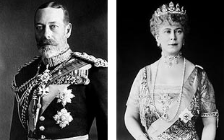
His Majesty King George V and Her Majesty Queen Mary attended the first 'royal shows' in 1912 and 1919, becoming Patrons of the Royal Variety Charity from 1921. Life-Patronage from the reigning monarch continues to the present day, demonstrating the Royal Family's long support & affection for the entertainment industry
-
1921 - THE ROYAL VARIETY BECOMES AN ANNUAL EVENT
-
The previous Royal Performances in 1912 and 1919, although huge successes, had been 'one-offs', but the 1921 show was the first of the more regular stagings..
It was the brainchild of Harry Marlow, Chairman of the Variety Artistes' Benevolent Fund (the previous name of the Royal Variety Charity), to establish a regular series of shows, and his idea was warmly welcomed a Buckingham Palace. Indeed, HM King George V, a great fan of variety, agreed to become Life-Patron of the charity and decreed in the same year, that the Royal Variety Performance would become an annual event. Her Majesty Queen Mary joined her husband the King, as joint Patron of the charity, shortly afterwards.
His Majesty King George V added that 'the Monarch or a senior member of the Royal Family, would attend an annual Performance, in aid of Brinsworth House and the Royal Variety Charity, once a year thereafter, to demonstrate the Royal family's love and support for the entertainment industry and its associated charity.'
There were fears that the public might not repsond so well and at first tickets sold slowly. But the timely announcement of Princess Mary's engagement to Viscount Lascelles and the news that their first public appearance would be at the Hippodrome, guaranteed a full-house.
A feature of the evening was the recital by Milton Hayes of his own verse, The Book of Variety. Another star was bass, Malcolm Neil McEachern.
The evening raised £2,000 for the charity, which included £50 which the King gave himself for his seats in the Royal Box!
An act which gained the King's particular applause was G.S.Melvin's hornpipe. It was said during his naval career His Majesty King George V had been very partial to performing a hornpipe himself.
Billy Merson was one of the best comedy acts of the night. His hilarious antics in the musical comedy Pieces brought roars of laughter from the audience. Milton Hayes, dubbed the 'Laugh-Smith with a Philosophy,' seemed to be a great favour with the Royal party. In addition to reading from the Book of Variety, he gave a send-up of political propoganda, which was one of the funniest turns of the evening.
-
1922 - THE ROYAL VARIETY JOINED BY THE QUEEN OF NORWAY
-
The Queen of Norway joined the Royal Party for this year's show, which for the second year running was at the Hippodrome. Their Majesties were treated to a cast list generally agreed to be more varied than that of the prevvious year.
Arthur Prince, who had appeared in the very first 'royal show' was again a big hit with his ventriloquist act, ably assisted by his dummy Jim. Their interpretation of the 'Love Affair of Yussif Hassan' drew a large round of applause.
A further oriental note was struck by Kharum, described as 'The Persian pianist from the land of Omar Khayyam'. His dexterity at the keyboard was greatly admired. He could play popular melodies of the day intermingled with Chopin and amused the audience hugely with one tune played entirely with his left hand.
The Scots comedian Will Fyfe was another great success, especially with his rendition of a 'hardy old farmer' who sang lustily about being 'ninety-four today'.
Rather more unusual, but equally popular, was a cartoon show called 'Tishy' created by Tom Webster. He was in the stalls during the showing of the film about the crazy horse's adventure, but was called on stage with enthusiastic acclaim at the end to receive the justly earned applause for waht proved to be an immensely popular item.
And, in keeping with the traditions of variety, the Flemings provided a strong-man act that certainly appealed to His Majesty.
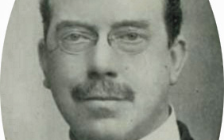
SIR OSWALD STOLL (born 1866, died 1942, knighted by George V in 1919) was Executive Producer of the Royal Variety Performance between 1912 and 1926
-
1926 - First Broadcast of Royal Variety - on radio
-
Up until 1926 the only way to get a taste of the unique atmosphere of such a 'royal night' was to queue for a ticket. However, this was the year this changed, for 1926 was the year of the first-ever broadcast of the Royal Variety Performance. It was, of course, on radio, and to overcome the potentially awkward silences during visual acts, broadcasters would provide 'commentaries' on the performances, rather like modern-day sports commentators.
Certainly the small radio audience (at the time) and those at the Alhambra enjoyed an evening of rich variety. There were comedians Robb Wilton and Dick Henderson, dancers Carr and Parr and a leading ballad singer of the time, Lillian Burgiss, who enthralled the audience with her version of The Song That Reached My Heart.
Jack Hylton, (in later years a successful producer and manager of the Crazy Gang) and his Band were the first variety orchestra to appear in a Royal Variety Performance. In fine fettle that day, they played, among other numbers, Laugherland, Rose Marie, Babette and Bab Bam Bammy Shore.
A point of interest is that none of the performers in the 1926 Royal Variety Performance had appeared in any of the six previous shows. The Stage described the programme as "a good working bill' considering the self-imposed desire to have an all-British and new cast."
[In 1970 almost the same criteria applied, with only one of the cast (Max Bygraves) having appeared before in a 'royal show'; everyone else was making their debut].
Notable among the 'newcomers' of 1926 were the Tiller Grils and the comedian and singer Dick Henderson - father of the later star of Royal Variety Performances, Dickie Henderson. With a bowler hat too small for his head, he personified the myth of the 'jolly fat man' and won over the audience with consumate ease.
Sir Oswald Stoll, who presented the show at the Alhambra, earned praise from The Performer for his efforts. The newspaper pointed out that because of the General Strike there was a chance that the Royal Variety Performance might have to be switched from the Thursday to the Saturday, thereby losing Sir Oswald the Alhambra's normal lucrative Saturday night receipts. Although this was not necessary in the end, Sir Oswald with characteristic gererosity was quite prepared to allow the switch. The Performer went on to say, "There are few men in show business who have with so little ostentation or attempt at seeking the limelight achieved the prominence of Sir Edward Stoll."
Fear and anxiety have been the curse of many a performer's life, but spare a thought for friends and relatives who suffer the agonies at second hand! Billy Bennett describes how his mother was able to cope with the problem on the night "My mother told me that as she sat in the circle and watched me she almost died lest I should forget my words before Royalty, and she told me that she repeated them as they fell from me - much to the amusement of the people sitting near her!"
This year's show revived hopes that music hall was making a come-back to the British scene, the Daily Mail writing of "this essentally British institution coming into its own again."
The Performer said of the show "....that is one of the useful services rendered by such an event. It does help to bring variety into prominence out of the obscurity to which it has so unfairly been relegated by many of the newspapers."
-
The 1930's
-
1930 saw an ever increasing involvement by the BBC; apart from the simple broadcasting of the show, BBC broadcaster, Gillie Porter was a huge success on stage, and Jack Payne and his BBC Band closed the show.1935 proved a very special year, coming in the Silver Jubilee Year of His Majesty King George V and Her Majesty Queen Mary. Despite the King's illness, excitement and expectation was ever greater than usual and applications for tickets were received from all over the world; an American millionaire offered £500 for two seats! In every respect the show formed a fitting climax and, sadly, an appropriate finale to the great support that His Majesty King George V had given to the variety profession, for the 1935 Royal Variety Performance sadly proved to be His Majesty King George V's last. The Sovereign who, to paraphrase Sir Oswald Stoll's words back in 1912, had invited 'the Cinderella of the arts to the ball', died a few months later, in January 1936, leaving the Royal Patronage of the Fund to live on in his heirs and successors.
After one year's gap, during the short reign of His Majetsy King Edward VIII, the Royal Variety Performance came back with a flourish two years later in 1937. Once again at London's Palladium Theatre, but this time before His Majesty King George VI and Her Majesty Queen Elizabeth (the late Queen Mother), who watched their first Royal Variety Performance as Monarchs.
No-one could have foreseen the onslaught of War on the horizon, but the 1938 Royal Variety Performance, held at the London Coliseum for the first time in ten years, was to be the last until 1945. The finale of the show, involving around 250 artistes, was the biggest ever for the Royal Variety Performance and seemed an appropriate, if unintentional grand finale before the grim and desperate years ahead.
-
1947, Princess Elizabeth's first Royal Variety, with Laurel & Hardy
-
Laughter was the main theme of the 1947 Royal show at the Palladium. For the Royal Party it was already a happy occasion - the Princess Elizabeth appeared in the Royal Box with her fiance Philip Mountbatten and the romance of the occasion bestowed a special atmosphere on the evening. The young couple were married two weeks later on 20th November 1947.
The famous duo Laurel and Hardy were over from the United States for the show; Tommy Trinder and the Crazy Gang were once more outstanding and there were acclaimed performances from impressionist Jack Durant and female impersonator and ventriloquist Bobbie Kimber - a man who confused some of the audience as to his real gender!
But 1947 did not lack song either, with Gracie Fields already a veteran of 'royal shows' getting an exceptionally warm reception.
The King was clearly tickled by the evening, "We haven't laughed so much for years" he said later.
Despite his acknowledged success with Royal Variety audiences, Tommy Trinder showed that performers can be very superstitious. During a rehearsal, somebody asked if they could photograph the comedian. Tommy immediately refused and ran away, saying "the hit of the Royal Variety Show is always a comedian who does not have his picture taken at the dress rehearsal. It was Arthur Askey last year."
Val Parnell, who presented the 'royal show' later explained the policy of including a few foreign big-name acts at the expense of some home-grown talent. "We try to show off our variety business to Their Majesties The King and Queen to the best possible advantage. We cannot afford in a performance like ours, when people are paying 10 guineas for a seat, to experiment too much! The audience of a Royal Variety Performance is 'hard boiled' and there's nothing worse than for an act to be received in stony silence. I don't say that variety is exactly on trial at the show, but it is a test performance and obviously, for the sake of the business, we have to put on the very best possible show."
Billy Russell was a comedian of great skill who did not fear the difficult first spot. His appearance and his make-up of large moustache, the unkempt clothes and his watch chain were more than enough to make his audience roar with laughter.
Irving Berlin's musical Annie Get Your Gun was taking London by storm in 1947 and Dolores Gray, star of the show, was invited to appear before Their Majesties. This called for split-second timing on her part. The moment the curtain fell on the evening's performance of Annie Get Your Gun, she had to dash from the Coliseum to the Palladium, arriving in the wings just one minute before her cue!
After over 40 years in showbusiness, Laurel and Hardy made their Royal debut in 1947 in a piece specially written for the night. Stan Laurel, a former member of Fred Karno's theatre company who had made his move to America along with Charlie Chaplin, was no stranger to the boards. Oliver Hardy had started out in theatrical management and played villains in his early films before teaming up with Laurel to form the most famous comedy duo in the world. Their appearance at the 1947 Royal Variety Show was a high point in the limited variety tour they made of England - a tour in which they were received with great warmth and enthusiasm wherever they played.
-
1948, Danny Kaye and a 13 year old Julie Andrews
-
One of the world's great showbusiness stars, Danny Kaye, the American comic, dancer and singer, was a feature of the 1948 show at the Palladium and among other big names were comedian Ted Ray, Arthur Askey and Ted Heath and his band. But in many ways the performance was stolen by a thirteen year old girl, Julie Andrews.
She won the hearts of the audience with her own solo spot near the end of the first half and she rounded off the night with a beautiful rendition of the first verse of the National Anthem. "It was a thrilling finish" said one critic. The King and Queen's verdict on the show "One of the best programmes we have ever seen."
Charles Henry from Moss Empires described the tension behind the scenes. "It is" he said "an extraordinary thing how some people react to the importance of such an occasion as the Royal Variety Performance. At a crucial moment as one of the comedians was about to go on stage, he came to me and told me some gags and stories and asked me if he should put them in. Another artist, a musician in one of the bands, approached me as I was hastily doing something of importance, handed me a one pound note and asked me if I could get him four programmes. I had a lot on my mind at the time and told him so. It is of course a momentous occasion for the artists" Henry explained "and nerves play a big part."
Danny Kaye's success at the Palladium earlier in that year had been little short of meteoric. The critic John Barber had headlined his story on the young New York star "Kid From Brooklyn Conquers London." Another in the audience for Kaye's first night recorded that it took 'just ninety-five seconds' for him to establish himself as the "greatest personal success in the history of English music-hall for the last thirty years." Every other London critic was in agreement. So was the theatre going public. And so was the Royal Family who went to see him on more than one occasion.
With adulation like this, it was a foregone conclusion that Danny Kaye would be invited to appear in the 1948 Royal Variety Performance. Expectation was high, perhaps too high, for as many artistes have found, the audience on these occasions is like no other. Danny Kaye either failed to appreciate this, or misjudged it. One way or the other, he went down well, but with nothing like the stupendous acclaim that everyone had anticipated.
All the same, he had the opportunity to end on a high note, joining Bud Flanagan and Chesney Allen in a chorus of their ever popular 'Underneath The Arches', before the three of them sang 'There's No Business Like Showbusiness.'
As an indication of the reverence in which the Royal Variety Performance is held in the profession worldwide, the British press reported the Hollywood film in which Danny Kaye was working at the time had to be halted for ten days while he made the trip to London for the show - at an estimated cost of £12,000!
Ted Ray, who appeared on the same bill at the Palladium as Danny Kaye, used to introduce him to the audience each night, and the two of them became great friends. After the show one night Kaye asked if he could borrow one of Ted's pieces of soap, which was still subject to rationing. Ted Ray was happy to oblige but asked to have it back when his friend had washed. On his return to the States, Danny Kaye sent him a whole case of soap! The press, however decided that there was some rivalry between the two stars and asked 'Which is better, Kaye or Ray?'
On the night of the 'royal show' there was little doubt, though Ted Ray - who opened with the line "I've been in this business 40 years and now I'm down to doing a one night stand" and continued as a storming success - would never have seen himself as 'better' than Danny Kaye.
Following her overwhelming success on the night, Julie Andrews offered her thanks in the pages of The Stage, in the following announcement:- "From the Old Meuse, Walton-on-Thames, Surrey, To all my friends, Mummy and Daddy join me in a big Thank You for your great help and guidance, and especially dear Madam Stiles-Allen for her patience and loving care during lessons" JULIE ANDREWS
To sound a sadder note, this was the last performance of the comedienne, Nellie Wallace, who collapsed as she came off the stage and died several days later.
-
The 1950's
-
In 1951, the audience was in for a surprise this year when the Royal Party arrived, for along with Her Majesty The Queen and Princess Margaret were nurses Ruth Beswetherick and Doreen Pearce, who had been nursing His Majesty King George VI through his recent illness. His Majesty was too ill to attend the Victoria Palace but as Her Majesty the Queen told an enquiring Bud Flanagan: "He is going on very nicely, thank you." And when told how sorry everyone was that His Majesty couldn't attend, Her Majesty the Queen replied, " So is he, but he is listening in." Richard Murdoch and Kenneth Horne appropriately sang, "We're very sorry someone isn't here today and here's a special message that we'd like the band to play" followed by "Here's a health unto His Majesty."
In 1952, much was expected of the year's Royal Variety Performance and much attained, coming as it did as the first of Her Majesty Queen Elizabeth II's reign. "This is the best show of all" was Her Majesty's verdict on the programme, which included a number of artistes making their Royal debut, among them the Beverley Sisters, singer Ian Wallace, and zany comedian Norman Wisdom. Tony Hancock was a particular hit with the Duke of Edinburgh in his sketch featuring a lieutenant-commander in the Royal Navy.
1955 had two Royal Variety Performances, the first staged outside the capital for the very first time at the Opera House in Blackpool, and eatured many acts familiar to Blackpool audiences. Highlights included Reginald Dixon, Jimmy Jewel & Ben Warriss, George Formby, Arthur Askey and a couple of young comedians by the name of Morecambe & Wise.
The 1955 London audience, saw Benny Hill, Lena Horne and the Chinese Classical Theatre Company and the year also marked the arrival of Independent Television, who made a bid to televise the show. The bid was turned down by the Lord Chamberlain's office on the grounds that television might endanger variety theatres all over the country!
Perhaps it was just as well that 1955 had two Royal Variety Performances, for the 1956 one has gone down in history as the Royal Variety Performance that never was. All the performers and theatre staff were busy in rehearsals, when Val Parnell called a halt to make an announcement, 4 hours before curtain-up. He informed them that he had just heard from the Palace that the evening's Royal Variety Performance had been cancelled due to the mounting Suez Canal crisis and that at that very moment British troops were landing in Port Said, Egypt. The Soviet Union was threatening to retaliate with rockets unless British and French forces accepted a ceasefire. Her Majesty quite rightly felt it in-appropriate to attend. There was widespread disappointment amongst the cast. The Crazy Gang had specially put together a burlesque of A Midsummer Night's Dream. Laurence Olivier, Vivien Leigh and John Mills were on the bill. Liberace broke down on the stage in tears, whilst Gracie Fields did what she could to comfort others in the cast as deeply affected, but it was the Cockney comedian Jimmy Wheeler who restored flagging spirits when he took out his violin and announced "I've rehearsed this bloody act for a fortnight so somebody's gonna hear it" and promptly went into his full routine, adding several gags that would never have found their way into the show proper!
1958 marked the first of the long-running series of Delfont/Nesbit productions and began the partnership that year at the Coliseum with a large and impressive cast including Roy Castle, Max Bygraves, Tony Hancock, Julie Andrews, Rex Harrison, Norman Wisdom and Eartha Kitt.
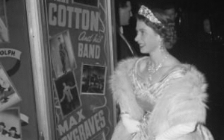
Her Majesty the Queen arriving at the London Palladium in 1952 for her first Royal Variety Performance as Queen.
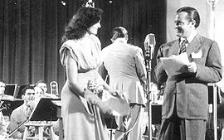
Bob Hope with Jane Russell at the Royal Variety Performance in 1954
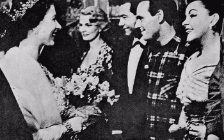
Her Majesty the Queen presented to Judy Garland in 1957
The 1960 Royal Variety Performance was the first to be televised and will probably always be remembered as the Sammy Davis Junior's show. "In eight electrifying minutes", wrote the Daily Sketch, "this entertainer made the word 'star' seem inadequate".
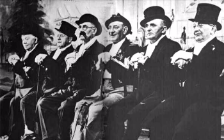
The Crazy Gang at the Royal Variety Performance 1960
-
1963 - The Beatles
-
1963 was the year that Beatlemania hit the Royal Variety Performance.
By the time of the ''royal show' at the Prince of Wales Theatre (near London's Leicester Square) on 4th November 1963, the Fab Four from Liverpool were already big stars. Their first single Love Me Do had made it to Number 17 in the British charts in September of the previous year. In January '63, their second single, Please Please Me, topped the NME's Independent charts and in April, From Me To You topped the UK's official charts; followed by She Loves You in August. So by November, Beatlemania had swept the country like a ferocious gust of wind.
It was a shrewd move on the part of Executive Producer, Bernard Delfont, to book the band on to the Royal Variety Performance when he did. The timing was perfect. They were still the cheeky mop-top 'boy's next door' from Liverpool who only a year previously were largely unknown to the British public. Their wit and charm in 'courting' the press in the weeks leading up to the show, contrasted spectacularly with being booked to perform on the most prestigious stage of them all; with all the pomp and circumstance of 'London ceremony.' One journalist even asked if they would 'tone down their broad scouse accents for the show' to which McCartney replied 'we don't all speak like the BBC you know!'
The timing was pretty good for The Beatles too! ITV had been chosen to broadcast the show and recorded their most viewed show of all time when it was broadcast a week later, on 10th November 1963 to 21.2 Million people! The group achieved their fourth British Number One Single of 1963 with I Wanna Hold Your Hand, days after broadcast.
Despite technical problems in rehearsals, it was decidedly brilliant on the night, with all of the audience, including the Queen Mother, enjoying their performance immensely. One news commentator said, "Never in all my years of observing Royal Variety audiences, have I known this usually starch, 'on their best behaviour' audience, unbend so quickly and completely."
But there was much more than just The Beatles to enjoy. The bill included Marlene Dietrich and Burt Bacarach, Joe Loss and his orchestra, Charlie Drake, the Clark Brothers, Dickie Henderson and Steptoe & Son - alias Wilfred Brambell and Harry H. Corbett.
Many considered the 1963 show the best yet.
The Beatles attracted ecstatic fans outside the Prince of Wales theatre and through the Sunday rehearsals the noise of the throng could be heard by the artistes on stage. It was even necessary to construct a screened passageway between the theatre and the hotel next door, where The Beatles were staying, in order to get them in and out of the theatre without being seen.
The effect of the crowds obviously affected the other artistes on the bill and Marlene Dietrich made a point of always being in evidence when the photographers were around!
During rehearsals Paul McCartney managed to get his guitar caught in the curtains, but on the night itself The Beatles took the show by storm, performing 4 songs: 'From Me To You', 'She Loves You', 'Till There Was You' and 'Twist and Shout' - the video recording of their performance can be viewed on the 1963 Archive page.
On introducing 'Twist and Shout', John Lennon passed into Royal Variety history when he made his celebrated suggestion that "those in the cheap seats should clap their hands; whilst the rest could just rattle their jewellery!"
As part of his act Charlie Drake performed a dance with half a dozen girls, in the course of which he turned to the Royal Box and said, "I was so pleased to see your horse won at Kempton yesterday, Your Majesty", which was rather a surprising thing to say in the middle of a Royal Variety Performance.
In an attempt not to be outshone by The Beatles, or anyone else, Marlene Dietrich dazzled the audience with a sequin-covered evening dress and enchanted them with a range of songs that included 'Honeysuckle Rose', 'Where Have All the Flowers Gone?' and her all-time favourite 'Lilli Marlene'.
Max Bygraves spoke for many on the bill that night, celebrities in their own right but still capable of being star-struck, when he said, 'I used to see Marlene on the old silver screen and idolize her'.
1963 however, will always be remembered for The Beatles and for creating one of those rare TV moments where the world seems to stop. Everyone up-and-down Britain were glued to little black and white television sets to see the band perform. A unique TV moment that is rarely ever experienced by any artist; let alone repeated. Unless you are the Beatles of course! For in February '64, in the United States, it was like deja vu for the band, as an almost identical TV phenomenon happened when Bernard Delfont's brother, Lew Grade, booked them to appear on the Ed Sullivan Show.
In Britain though, for the British public and for the band's home country, The Beatles big television 'hysteria moment' was on the Royal Variety Performance of 1963.
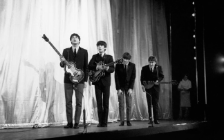
The Beatles - Beatlemania hits the Royal Variety Performance in November 1963 at the Prince of Wales Theatre
1963 was the year that Beatlemania hit the Royal Variety Performance.
By the time of the ''royal show' at the Prince of Wales Theatre (near London's Leicester Square) on 4th November 1963, the Fab Four from Liverpool were already big stars. Their first single Love Me Do had made it to Number 17 in the British charts in September of the previous year. In January '63, their second single, Please Please Me, topped the NME's Independent charts and in April, From Me To You topped the UK's official charts; followed by She Loves You in August. So by November, Beatlemania had swept the country like a ferocious gust of wind.
It was a shrewd move on the part of Executive Producer, Bernard Delfont, to book the band...READ MORE
-
1966 - ENGLISH WORLD CUP WINNING TEAM
-
1966 saw the entire English football team take to the stage after their World Cup triumph, and in 1967 Sandie Shaw will be remembered for changing from her stage outfit to meet Her Majesty the Queen, "A mini is fine on stage, but I am told it would be more elegant to be presented to the Queen in something a little more special!".
1966 saw the entire English football team take to the stage after their World Cup triumph, and in 1967 Sandie Shaw will be remembered for changing from her stage outfit to meet Her Majesty the Queen, "A mini is fine on stage, but I am told it would be more elegant to be presented to the Queen in something a little more special!".
-
1968 - HER MAJESTY THE QUEEN MOTHER HAILS THE BEST YEAR YET
-
1968 was hailed by Her Majesty the Queen Mother, a seasoned connoisseur of music hall and variety, as being one of the best ever. Diana Ross used the opportunity to make a moving tribute to black civil rights leader, Martin Luther King, who had been assassinated earlier in the year.
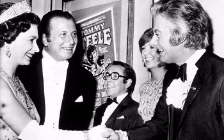
Royal Variety Performance in 1969. Her Majesty The Queen with Lord Bernie Delfont, presented to Ronnie Corbett, Cilla Black & Danny La Rue
-
1974 - Charity Name change to EABF
-
1974 marked an important year for the show's beneficiary, when the Variety Artistes' Benevolent Fund (the VABF), changed its name to the Entertainment Artistes' Benevolent Fund, marking its help for a wider spectrum of show business. The year also marked another 'first' in the show's history, by having a female compere for the first time, Noele Gordon.
-
1976 - First Live Broadcast
-
In 1976, after sixteen years of recorded television broadcasts, the Royal Variety Performance was broadcast live on television for the first time, and in 1977 a Royal Gala Performance was arranged to celebrate Her Majesty The Queen's Silver Jubilee. Lord Delfont and Lew Grade joined forces to present a truly spectacular trans-Atlantic bill with Bob Hope as compere.
-
1979 - Louis Benjamin
-
In 1979, Lord Delfont handed over the organising and presentation of the Royal Variety Performance to Louis Benjamin, and the show was held at the Theatre Royal in Drury Lane, for the first time in its history.
-
1980 - Her Majesty the Queen Mother's 80th birthday
-
1980 had particular significance, as it marked Her Majesty the Queen Mother's 80th birthday, and was devised as a salute to Her Majesty, by presenting a programme that spanned and reflected the very best in the field of light entertainment, from a nostalgic look back to the 1930's to the exciting tempo of the 1980's.
-
1981 - Sponsrship introduced
-
1981 saw another innovation, stimulated by the need to counter the mounting costs of staging the Royal Variety Performance. For the first time, sponsorship was introduced to pare down, in the words of EABF General Secretary, Reg Swinson, "unavoidable ever-increasing production costs, as a prudent and acceptable alternative to increasing seat prices". Louis Benjamin call also be acknowledged as the initiator of increasing television fees, for the UK and abroad, brochure advertising and the introduction in 1981 of sponsorship.
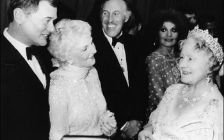
Her Majesty The Queen Mother presented to Larry Hagman, Mary Martin,Bruce Forsythe and Cleo Laine in 1980.
-
1986 - BBC ALTERNATE WITH ITV IN absorbING cost of production
-
1986 marked the first year that the BBC produced and presented the show, taking over from the helm of the EABF's, Louis Benjamin.
From then on, broadcasting and the cost of production of the annual Royal Variety Performance alternated each year between the BBC and ITV, until 2010.
-
2007 - Britain's Got Talent
-
Since the first series of the annual television talent competition, Britain's Got Talent, in 2007, the show has generously donated a proportion of the money raised from viewer's telephone votes, to the Royal Variety Charity.
In return, the Royal Variety Charity, arranges that the series winner of the show is awarded a coverted spot on the annual Royal Variety Performance.
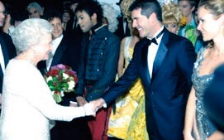
Her Majesty The Queen presented to Simon Cowell at the Royal Variety Performance 2007, at the Liverpool Empire Theatre, following the performance of the first winner of Britain's Got Talent, Paul Potts
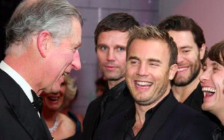
His Royal Highness the Prince of Wales presented to the reformed Take That in 2006, and then again with Robbie Williams, in 2010.
-
2010's Dawn of a decade of resurgence
-
The 2010's began as an historic decade for many reasons.
By the end of 2010 itself, Giles Cooper was elected as the new Chairman and he, in partnership with Life-President Laurie Mansfield, took the helm of the show and launched it into a new era, beginning a period of popular resurgence...
2011: began the start of a new 10 year deal with ITV, with ITV bearing production costs
2012: celebrated with a spectacular Centenary RVP at the Royal Albert Hall (for the 1st time)
2013: marked the beginning of a new dawn for the show being the first of its 2nd 100 years
2014: attended by the Duke and Duchess of Cambridge for the first time
2015: not only the most successful in terms of profit in the history of the RVP, but was the first officially in aid of the charity's new name, the Royal Variety Charity. It was also attended by Prince Harry for the first time.
The 2010's began as an historic decade for many reasons.
By the end of 2010 itself, Giles Cooper was elected as the new Chairman and he, in partnership with Life-President Laurie Mansfield, took the helm of the show and launched it into a new era, beginning a period of popular resurgence...
2011: began the start of a new 10 year deal with ITV, with ITV bearing production costs
2012: celebrated with a spectacular Centenary RVP at the Royal Albert Hall (for the 1st time)
2013: marked the beginning of a new dawn for the show being the first of its 2nd 100 years
2014: attended by the Duke and Duchess of Cambridge for the first time
2015: not only the most successful in terms of profit in the history of the RVP, but was the first officially in aid of the charity's new name, the Royal Variety Charity. It was also attended by Prince Harry for the first time.
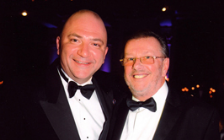
Executive Producers: Chairman Giles Cooper with Life-President Laurie Mansfield at the Royal Variety Performance 2011 at the Lowry Theatre, Salford
-
2011 - ITV granted 10 year deal
-
The 2011 Royal Variety Performance was special for a number of reasons. Firstly, it marked the beginning of a new ten year broadcasting deal with ITV Studios - negotiated the previous year by EABF Life-President Laurie Mansfield. It was also the first year with newly elected Chairman Giles Cooper at the helm.
2011 was also the first time that The Princess Royal, Princess Anne had been the primary Royal Variety guest of honour since 1968 (the year of Giles Cooper's birth!) and she was warmly welcomed with her husband Vice-Admiral Sir Timothy Laurence.
The show was staged at the relatively new Lowry Theatre in the newly built 'BBC Media City' in Salford, Manchester and provided a modern, high-tech setting for this year's Royal Variety.
Host, Peter Kay presented a truly memorable night of variety which began with one of the most spectacular openings the show has ever seen - in what was titled the Royal Variety Drumming Ensemble. The trumpeters of the Heavy Calvary and Cambrian Band began with Hayley Westenra joining them to sing the National Anthem, followed by a drumming ensemble featuring the cast of Stomp, the Royal Marines Corps of Drums, Kodo, The DHOL Foundation and 3RUN!
Pop music came from the fantastic Pixie Lott and Cee Lo Green, but the show will be remembered for featuring two stunning female vocal performances. The first delivered by Leona Lewis, with a cover version of 'Run' by Snow Patrol - later to become a massive hit for the X-Factor winner.
Then, Lord Andrew Lloyd Weber himself introduced a very special performance of Phantom Of The Opera to celebrate its 25 years in the West-End, where Nicole Scherzinger, playing the role of Christine, was joined by four previous male leads of the legendary musical, John-Owen-Jones, Ramin Karimloo, Earl Carpenter and Simon Bowman. Her performance was breathtaking.
As if Peter Kay's hilarious antics weren't enough, further comedy came from Jason Manford, Omid Djalili, Greg Davies and Tim Minchin, but one of the further highlights of the show was from another West-End musical, Singing In The Rain...
The stage of the Lowry was transformed to allow real water to fall as rain for Jonathan Church's production of Singing In The Rain and provided one of the most memorable performance in Royal Variety history, with the amazing Adam Cooper as lead.
It was the most incredible production feat (in the middle of a 'run as live' variety show), to produce water falling as 'real rain' with the cast of dancers splashing in puddles! It seemed as if the production team had miraculously pulled it off, to the delight of the audience. That was until the break for the interval, when the Singing In The Rain stage set had to be quickly cleared behind the curtains.
Unfortunately, one of the Lowry's theatre staff knocked over a section of the set, cutting off all of ITV's radio communications and VT connections! The result was a panicked team of technicians and production staff having to re-wire communications frantically through the interval and causing a 45mins delay. However, Peter Kay came to the show's rescue showing his supremacy as a top-flight comedian, with some superb ad-libbing throughout.
In the second half, the audience, unperplexed by the delay, were treated to the wonderful sounds of classical crossover quartet Il Divo, before the arrival of Royal Variety favourite and music legend Barry Manilow.
Manilow however was not without his technical problems - whilst doing a duet of Mandy with his former, younger-self (presented on a screen), syncing issues caused him to request to re-perform the song. The producers quickly agreed and so for the first time in Royal Variety history, an artist was allowed to re-record his performance to provide a better production for TV. The audience were delighted by the unexpected events throughout the show and Her Royal Highness Princess Anne clearly enjoyed the uniqueness of the whole occasion!
The show concluded with a terrific performance by American legend Tony Bennett, after which a superb finale with the whole cast ended a truly amazing night. Albeit an eventful one!
-
2012 - 100th anniversary
-
2012 was a landmark and very special year for the Royal Variety Performance; being 100 years since the show's beginnings in 1912. It was also the Queen's Diamond Jubilee year and if that wasn't enough, it was also the year that London hosted the Olympic Games!
The Royal Albert Hall was booked for the first time in the show's history and Her Majesty The Queen attended her 39th Royal Variety, accompanied by HRH The Duke of Edinburgh, attending for his 27th time! The increased capacity of the Albert Hall (twice that of the London Palladium) meant it would be a good year for the charity and together with the venue's grand opulence, all agreed that it would provide the perfect setting for the show's very special, Centenary Performance.
The Mansfield Cooper partnership was now in full swing, but the technical misfortunes of the previous year in Manchester were still at the back of everyone's minds and the Albert Hall was not without its challenges! Not built as a theatre and with very little backstage facilities, the show presented many obstacles for the production team to overcome. No curtains meant set changes would be difficult and where to house a cast of over 200 performers, with numerous sets, sound equipment and props, added to the challenge to make this the show's 100th year, extra special.
The venue was booked for an entire week to allow for numerous technical and artist rehearsals. The University buildings behind the Hall were hired for dressing room and storage facilities (with a security tunnel linking to the Hall's backstage area). The orchestra were placed on a platform suspended from the ceiling of the venue! Two levels of staging were built to allow presenters and comedians to provide 'links' from the upper level, whilst sets were changed in darkness on the lower level. Huge video screens were installed to enable the showing of clips from previous 'royal shows' over the previous 100 years.
The international cast was one of the most spectacular ever presented.
David Walliams was chosen as the primary host and was assisted during the night by various others including Bradley Walsh and Amanda Holden. It was also decided that another nice celebratory addition would be to allow the odd introductory segments to previous hosting legends of the Royal Variety, which included Sir Bruce Forsyth KBE, Jimmy Tarbuck OBE, Des O'Connor CBE and Ronnie Corbett CBE.
Her Majesty The Queen and HRH The Duke of Edinburgh were welcomed to the Albert Hall by Laurie Mansfield and Giles Cooper and were presented with a bouquet & show programme from Cooper's children (Rory aged 9, and Heather aged 7). Their Majesties were given a hugely warm welcome on entering the Royal Box and after the playing of the National Anthem, there followed a spectacular entrance by David Walliams - suspended by a 'zip wire' Walliams descended to the stage to the music of the James Bond theme tune - referring to the fantastically popular 'Bond intro' to the London's Olympic Games 'Opening Ceremony' - only 2 months previously.
The show began with Girls Aloud featuring Cheryl Cole, who specially reformed for the night, after which followed an incredible celebration of the TV talent show, Britain's Got Talent, which included street dance group Diversity, gymnasts Spelbound, singer Paul Potts and the ever popular Stavros Flatley and his son.
With only just over a year since winning X-Factor, the huge rise to international fame of One Direction was celebrated with their first-ever performance on the Royal Variety Performance. The boys entered by walking to the stage through the stalls, much to the delight and screams of female members of the audience!
More comedy came from the fantastic Welsh comedian Rhod Gilbert and cross-over act Alan Carr, but it was Bill Bailey and his 'orchestra of car horns' that provided a real highlight.
More pop music came from the ever-lovely Australian pop princess, Kylie Minogue and from the United States, Alicia Keys delivered a beautiful rendition at the piano of her huge hit ' New York'.
Classical music was represented too with an abundance of gold stars, in the form of Katherine Jenkins performing a duet with Placido Domingo, China's Three Tenors and the incredible Andrea Bocelli.
West-End musicals were represented by Heather Headley singing 'I Will Always Love You' from the Bodyguard, together with the lovely cast of Matilda.
Robbie Williams headlined the first half, providing fantastic performances of hits from his new album 'Take the Crown.' A nod to the career of his crooning father.
Britain's Got Talent 2012 winners Ashleigh and Pudsey, the Ballet Revolución and Circus Space gave the show real variety in its truest form and the evening was rounded off by amazing performances from music legends Rod Stewart and Neil Diamond.
The finale was probably one of the most memorable with the entire cast joining Neil Diamond for a rendition of Sweet Caroline.
The 100th anniversary evening was celebrated in style with the majority of the cast at a further fundraising event at a lavish aftershow banquet at the Hilton Hotel in London's Park Lane. The entire evening raised an incredible £740,000 for the Royal Charity.
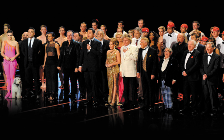
The cast of the 2012 Centenary of the Royal Variety Performance at the Royal Albert Hall,
-
2013 - start of new era
-
2013 marked the beginning of new era. Chairman Giles Cooper said in his introduction to the show programme, "Our charity, the Entertainment Artistes' Benevolent Fund, organisers and beneficiaries of the Royal Variety, has had to tackle some difficult decisions this year. Modernising the governance, operation and direction of a charity that has over 100 years of heritage, steeped in practices, traditions and the odd 'old habit', hasn't always been easy."
As the show's charity turned a corner, so did the Royal Variety Performance itself.
2013's show was, however, a daunting prospect following the huge production and financial success of the previous year's 'Royal Albert Hall Centenary Production', attended by Her Majesty The Queen in her Diamond Jubilee year.
'How do you top that?' everyone questioned. Well to start with, where better to begin the start of a new centenary for the world's longest running and most successful show, than back at its spiritual home of the London Palladium.
Their Royal Highnesses The Prince of Wales and the Duchess of Cornwall were back in attendance for the first time since the attack on their car during the student riots of 2010. Security was tight, but it didn't dampen a hugely entertaining evening.
Liverpudlian comedian, John Bishop, took on the role of host for the first time and speaking of his Royal debut, he said, "As a child, the Royal Variety Show was like the Grand National and the FA Cup Final - it was something our family always watched (the only difference being we didn't bet on the winner!). To host a show with such heritage is something I never imagined I would do and I trust my parents will be proud when they take their seats in the audience, although I have told my Dad not to shout 'Come on son!'...it's not a match or a horse race!"
The show was opened by a spectacular multi-artist production by Gary Barlow OBE. who performed a debut of his new hit, 'Let Me Go". Gary said "I love the Royal Variety Show, there's not many shows that can claim to stand the test of time like this one. It's always such a lovely night the whole family can enjoy. I know if I wasn't performing on it, I'd be watching it!"
A true variety bill was presented including dance from Torvill & Dean and Flavia Cacace and the cast of Dance 'Till Dawn. Comedy was in abundance for Their Royal Highnesses with highly entertaining slots from Jimmy Carr, Seann Walsh and Jason Byrne, but the most memorable comic slot came from Dame Edna Everage, who entered the Royal Box as part of her set, pretending she was lost in an attempt to find the best seat in the house! It provided a hugely entertaining bit of fun for the royal guests.
Pop music was also in abundance from John Newman, Mary J Blige, Rizzle Kicks and the amazing Jessie J.
Olly Murs closed the first half and was joined on stage by a surprise appearance from Robbie Williams! Ollie and Robbie performed a massively entertaining song and dance duet of 'I Wanna Be Like You' - The Monkey Song from the Jungle Book!
West-End musicals were represented by Sam Mendes' Charlie & The Chocolate Factory, Harry Hill's new X-Factor musical, 'I Can't Sing' and Lord Andrew Lloyd Weber's new musical, Stephen Ward, about the Profumo scandal of the 1960's.
Bryn Terfel, Caro Emerald, together with Hungarian shadow artistes (and Britain's Got Talent winners), Attraction, added to the variety flavour of the night, which was rounded off by the appearance of Chas and Dave for the first time on the show!
A hugely entertaining Finale included the entire cast singing Chas and Dave's 1983 hit 'London Girls'!
-
2014 - Duke & Duchess of Cambridge attend for first time
-
The 2014 Royal Variety Performance returned to the London Palladium and welcomed the Duke and Duchess of Cambridge for their first time; the Duchess being 5 months pregnant with Princess Charlotte.
The show will be remembered for the hilarious anecdotes of host Michael McIntyre who got so enthused by the audience reaction that he ran over by 40 minutes!
Highlights included Ed Sheeran and Ellie Goulding appearing on the Royal Variety for their first time, the hugely successful One Direction, Britain's Got Talent winners Collabro and the amazing Dame Shirley Bassey who proved that after all these years she is still one of the greatest female singers of all time.
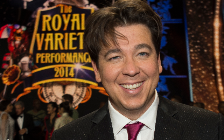
Michael McIntyre hosts the 2014 Royal Variety Performance in the presence of the Duke and Duchess of Cambridge
-
2015 - Royal Variety Charity & Prince Harry attends for first time
-
The Royal Variety Performance returned to the magnificent Royal Albert Hall for only the second time in the show's history and was attended by HRH Prince Harry for the very first time.
2015 was also the year that the EABF changed its name to the Royal Variety Charity for on 26 June 2015, the Executive Committee of the EABF met for an historic Annual General Meeting. Chairman Giles Cooper had previously gained approval from the Deputy Prime Minister's Office to change the name of the charity and Buckingham Palace and the Cabinet Office followed by awarding the charity the honour of official use of the title 'Royal' within the charity's name. The Executive Committee subsequentlyvoted to adopt the name change with immediate effect.
In terms of profit for the Royal Variety Charity it proved by far the most successful in the history of the event. Chairman Giles Cooper commented, 'the size of the Albert Hall obviously helped, but primarily we 'priced the house' more agressively and this combined with the introduction of selling tickets online for the first time resulted in 2015 being an enormous success',
Award-winning actor and comic Jack Whitehall (age 27) became the youngest ever host of the Royal Variety introducing performers from around the world, including music legends Sir Elton John and Jeff Lynne's ELO. Pop superstars included Kylie Minogue and Little Mix, as well as the show's opening performance from the world's biggest-ever boy band, One Direction; in what was billed their last performance before taking a year's break.
A highlight included a magical moment from the cast of Disney and Cameron Mackintosh’s multi-award winning musical Mary Poppins, when Mary flew to the stage suspended by a wire stretching the entire length of the Albert Hall! Also taking to the stage was a spectacular water based acrobatic performance from the internationally renowned Cirque Du Soleil and Britain’s Got Talent winners Jules, Matisse and Friends.
More music came from the King of Latin Pop, Ricky Martin, Irish legends The Corrs and from the USA, The Killers front-man Brandon Flowers, Josh Groban and country singer Kacey Musgraves. Comedy came from Chris Ramsey, Romesh Ranganathan, Matt Forde and the cast of the Play That Goes Wrong who stole the show with some surprise star cameos including participation from Kylie Minogue, Josh Groban and Jack Whitehall!
The Queen of British soul Beverly Knight MBE performed the national anthem to kick off the show and later in the night sang a number from the record breaking musical Cats.
Before the show Jack Whitehall commented, “It's a tremendous honour to be hosting the Royal Variety Performance. Having been lucky enough to perform for Prince Charles and Prince William in previous years I look forward to the opportunity of sailing a little too close to the wind in the presence of Prince Harry this time round. It's my third time on the show and I still am yet to perform in front of the Queen, she must be really desperate not to see my act.”
The 2015 Royal Variety Performance proved the most successful in terms of profit for the charity, in the history of the event.
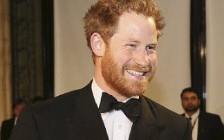
HRH Prince Harry attends the 2015 Royal Variety Performance at the Royal Albert Hall
-
2017 - ROYAL VARIETY HIT BY SUSPECTED TERROR ALERT
-
The Royal Variety Performance 2017 may well be remembered most for what happened before the show, rather than for the show itself.
Chairman Giles Cooper recalled, "I remember being held behind a police-line on Oxford Street, having Their Royal Highnesses Equerry on one mobile phone in one ear, seeing what looked like a platoon of Special Forces running down the centre of Oxford Street with machine guns in front of us, and having the Met Police's Chief Superintendent on another mobile phone in my other ear! It was very surreal and how we all managed to keep calm and ensure the show went on is testament to the professionalism of all involved."
Full story: CLICK HERE
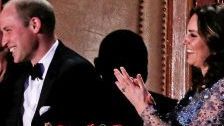
TRH The Duke and Duchess of Cambridge enjoy a great show despite a late start!
The Royal Variety Performance 2017 may well be remembered most for what happened before the show, rather than for the show itself.
Giles Cooper recalls, "I remember being held at a police-line on Oxford Street whilst having the Equerry to Their Royal Highnesses on one mobile phone in one ear, seeing in front of me what looked like a platoon of Special Forces with machine guns running down the centre of Oxford Street and having the Met Police's Chief Superintendent on another mobile phone in my other ear! It was very surreal and how we all managed to keep calm and ensure the show went on is testament to the professionalism of all involved." Full story: CLICK HERE
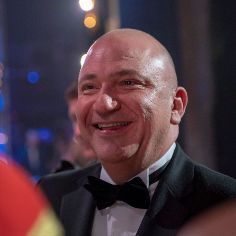
Giles Cooper at the 2017 Royal Variety Performance
-
2018 ROYAL VARIETY WELCOMES THE DUKE AND DUCHESS OF SUSSEX IN THEIR MARRIAGE YEAR
-
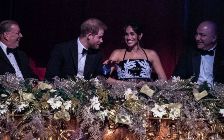
The Duke & Duchess of Sussex attend for the first time together, in the year of their marriage
The Royal Variety Performance 2018 was 'a first' on many fronts and in many respects felt like the beginning of a new era.
The show was staged at the London Palladium exactly six months (to the day) following the marriage of Prince Harry to Meghan Markle and the Duke and Duchess of Sussex attended their first Royal Variety Performance together on 19th November 2018. Her Royal Highness was pregnant with the Royal couple's first child and huge crowds gathered outside the Palladium, on a wet and windy November night to catch a glimpse of the Royal arrival. Full story: CLICK HERE
-
2020, the Covid pandemic hits, but the 'show went on' in Blackpool!
-
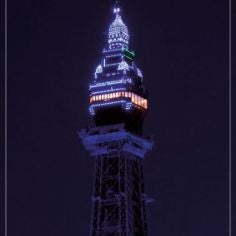
The Covid Pandemic hits, but the show went on!
2020 was the year of the Covid pandemic. Theatres and music venues were closed for most of the year, festivals and outdoor concerts were abandoned. However, 'the show went on' and the Royal Variety was staged to a virtual audience (the audience viewing a 'live stream' from their own homes and LED screens placed on theatre seats enabling the performers to see the faces of those watching!)
Executive Producer Giles Cooper commented: "As the horrible pandemic developed throughout the year, causing ever-changing restrictions, lockdowns and guidelines, so our plans had to change with every twist and turn and I lost count of the amount of different scenarios that we had to intricately plan for and then alas, start all over again. However, between the Royal Variety Charity and ITV Studios, our guiding mantra never changed, The Show Must Go On, and this typical showbusiness determination, combined with an enormous will between us all of wanting to help the thousands of people who worked in the entertainment industry that found themselves in really desperate situations, resulted in the stars aligning and enabled us to stage the show.
For us at the Royal Variety Charity, not being able to have a ‘physical audience’ meant we were denied the ticket revenue from the show, but the money earnt from television fees was a huge help in supporting an industry that was in unprecedented crisis. Without a ‘Royal presence’, there is no Royal Variety Show and, thankfully, as the wonders of technology allowed us to present a ‘virtual’ show and beat the virus in our own way, I’d like to thank most sincerely, Prince Charles, The Prince of Wales, for his fantastic video message of support which was broadcast during the 'live show', and meant so much to us all."
-
2021 The Royal Albert Hall
-
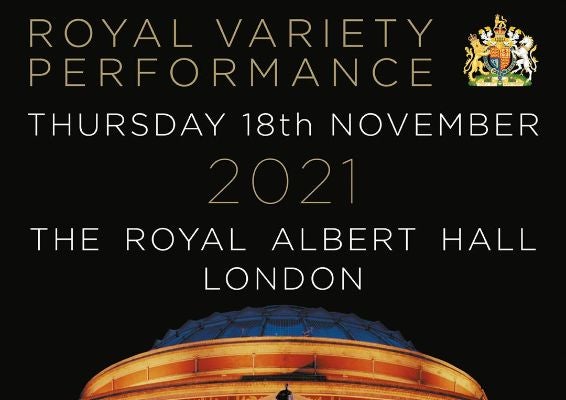
Royal Albert Hall attracts sell-out years for The Royal Variety Show
As the world got back to some kind of normality following the covid restrictions, 2021 wasn't without its challenges as further lockdowns were imposed, but the timing of the 2021 show on the 18th November 2021, allowed the 2021 Royal Variety to proceed as normal and so began a new era for the Royal Variety Show, with both a new five year contract with ITV Studios and a five year booking at the magnificent Royal Albert Hall!
The Royal Albert Hall is not only an outstanding venue for the show, but its larger capacity meant record ticket income for the Royal Variety Charity.
The Duke and Duchess of Cambridge attended for their fourth time in 2021 for a spectacular show which included the cast of Moulin Rouge, Sir Rod Stewart CBE, Elvis Costello OBE and Ed Sheeran MBE.
-
2022 - the loss of our long-standing Patron HM The Queen
-
The loss of our Patron HM The Queen
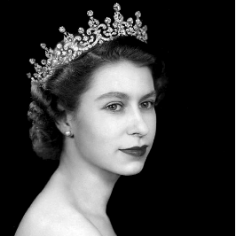
2022, saw the sad passing of our long-standing Patron
The 2022 show was dedicated to HM Queen Elizabeth II, who had served as Patron of the Royal Variety Charity for an incredible 70 years, and attended the Royal Variety Performance a record-breaking 39 times!
The show was attended by TRH Prince Edward and Sophie The Countess of Wessex for the first time and was hosted by Lee Mack, with emotional performances from Andrew Lloyd Webber, Gareth Malone and Gary Barlow.
-
2023 Royal Guests from Sweden
-
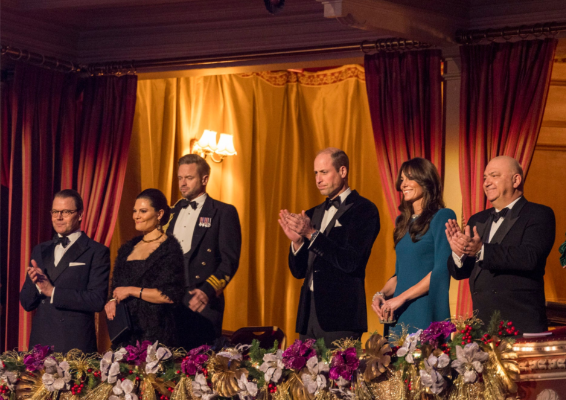
Princess Victoria & Prince Daniel of Sweden join The Prince & Princess of Wales!
2023 was a special year at the Royal Albert Hall, when TRH The Prince & Princess of Wales invited TRH The Crown Princess Victoria and Prince Daniel of Sweden to join them in the Royal Box to enjoy the show!
A fantastic Royal Performance was presented, led by host Bradley Walsh, and celebrating 100 years of Disney musicals!
